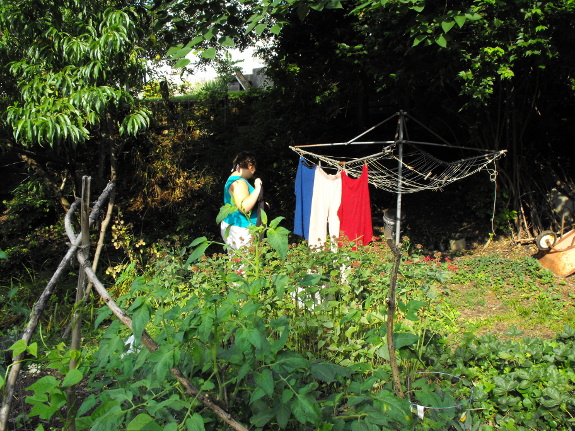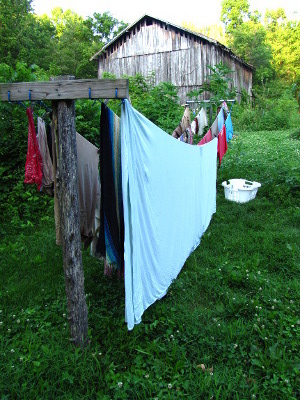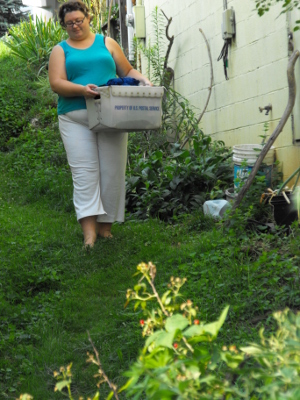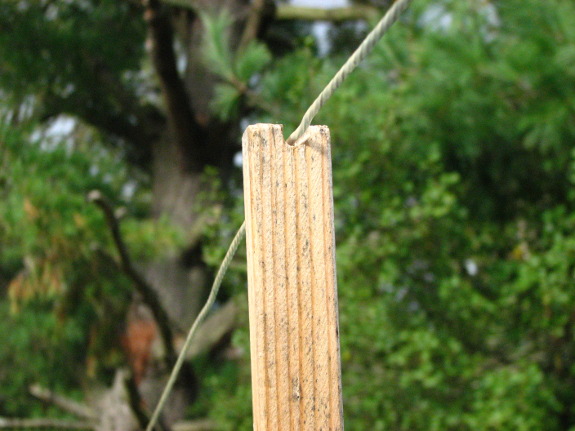
Advanced clothesline drying

 Before Errol made my first T-structure
clothesline, at the Farm (like yours), I had strung heavy wire going up
the ditch behind the house, some of it tied to branches, I guess, that
hung over the electric fence on the other side of the ditch. When
I had heavy things, like Errol's jeans, or maybe big towels or even
quilts or blankets, the line would sag --- as it does in your first
photo.
Before Errol made my first T-structure
clothesline, at the Farm (like yours), I had strung heavy wire going up
the ditch behind the house, some of it tied to branches, I guess, that
hung over the electric fence on the other side of the ditch. When
I had heavy things, like Errol's jeans, or maybe big towels or even
quilts or blankets, the line would sag --- as it does in your first
photo.
I had already learned, from Mrs. Vespa and Onie, to use tall
props, which is
one reason I still keep my eye out for fairly straight branches over 8'
long! My props were sometimes 10' long, and the best had a fork
at the end, for the line to rest in. These were essential, for raising
up the heavy load (the worst part of hanging out is if any drops in the
mud!!) Clothes dry so much faster if higher off the ground!
(Which is why I drape the socks and underwear on the high bars of my
reel.)
When Errol made the
T-frame, I went down to Onie and said, "He is trying to domesticate
me!" I loved my rambling line!!
In
winter,
especially, it is easier to dry sheets if you do NOT hang
over the line (for
they can freeze to the line)! And if you fold the wet sheet in
half, then in  quarters, it is easier to unfold
and hang, out in the cold. One of the ways I was taught to hang
out was to organize
the clothes before going out, as one takes them out of the
washing machine (or,
in your case, as you rinse and wring) --- so you have a pile of
underwear that you already know where you will hang, and have the
better clothes sort of shaken out and folded conveniently ready to hang.
quarters, it is easier to unfold
and hang, out in the cold. One of the ways I was taught to hang
out was to organize
the clothes before going out, as one takes them out of the
washing machine (or,
in your case, as you rinse and wring) --- so you have a pile of
underwear that you already know where you will hang, and have the
better clothes sort of shaken out and folded conveniently ready to hang.
You really need to be
particular, on damp days, or if you have alot to hang out and hope to
be re-using your line the same day! Not bothering to make sure
the clothes are completely right-side out, even, for example if you
wash them wrong-side out; and not shaking
them out so they don't clump, but are flat. Those
two rules, plus the awareness of drying high, if possible, and not
draping over the line, in the winter, unless you plan to turn the
article for the underside to be dried. These are my life-tested
rules!
| This post is part of our Tips from the Urban Homestead lunchtime
series.
Read all of the entries: |
Want more in-depth information? Browse through our books.
Or explore more posts by date or by subject.
About us: Anna Hess and Mark Hamilton spent over a decade living self-sufficiently in the mountains of Virginia before moving north to start over from scratch in the foothills of Ohio. They've experimented with permaculture, no-till gardening, trailersteading, home-based microbusinesses and much more, writing about their adventures in both blogs and books.
Want to be notified when new comments are posted on this page? Click on the RSS button after you add a comment to subscribe to the comment feed, or simply check the box beside "email replies to me" while writing your comment.

J --- Soap-making is one of the techniques I've never felt inclined to try --- we just use so little of it. (Hmm, maybe I shouldn't let the world know how bad my housekeeping skills are...) I seem to recall that urine and wood ashes can be used to make soap, but I think most modern homesteaders just buy lye and the other chemicals in the store. Herbs are generally just for scent. But that's all from my very vague knowledge from skimming blog posts here and there, so take it with a grain of salt!!
(Hmm, maybe I shouldn't let the world know how bad my housekeeping skills are...) I seem to recall that urine and wood ashes can be used to make soap, but I think most modern homesteaders just buy lye and the other chemicals in the store. Herbs are generally just for scent. But that's all from my very vague knowledge from skimming blog posts here and there, so take it with a grain of salt!!
Fritz --- If I'm visualizing this right, you basically made three simple props, right? I'd love it if you took a picture and shared!
Anna - yep, that's all it is, a stick to prop up the line. The hole that I drilled acts like the fork in the branch. The line sits in that.
I'll see if I can get a pic taken and shared.
Being pictured in this wonderful entry is my favorite way of being online that has ever occurred to me. It is not my most glamorous picture (me in pajamas) - but this lined up next to Mom's elegant depictions of "woman's work" touches a deep place in me.
It is a blessing to occur on the internet totally absent of my knowledge or opproval, out of my control, yet so eternal like landing in the canon of the world.
Or something...
Thanks Anna and Mom!
Fritz --- Feel free to email me photos at anna@kitenet.net. I could actually use some prop photos in the revised edition of the ebook if you don't mind sharing.
Alison --- Good point about fading colors! I'll have to add that to the revision of the ebook too. Gotta love the hive mind!
Gotta love the hive mind!
Maggie --- And speaking of the revised ebook, I'm going to put you in there too --- hope you don't mind. I actually thought the photos of you were extremely nice, especially the one of you walking with the basket.
I actually thought the photos of you were extremely nice, especially the one of you walking with the basket.
Thanks so much, Fritz! In case anyone wants to see Fritz's elegant clothesline prop in action, here's a closeup:
Soap is made from fat or oil and lye.
Stale urine can be used for bleaching because of it's ammonia content (converted from urea).
Doc --- It's funny how drying clothes on the line brings up such pleasant memories for so many people, and yet so few people still do it! I can't think of a better work environment than hanging clothes on the line.
Roland --- Thanks for adding the information I was too lazy to look up. Now that you refreshed my memory --- it's wood ashes you use to make lye, I believe.
Now that you refreshed my memory --- it's wood ashes you use to make lye, I believe.